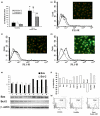Circulating plasma factors induce tubular and glomerular alterations in septic burns patients
- PMID: 18364044
- PMCID: PMC2447585
- DOI: 10.1186/cc6848
Circulating plasma factors induce tubular and glomerular alterations in septic burns patients
Abstract
Background: Severe burn is a systemic illness often complicated by sepsis. Kidney is one of the organs invariably affected, and proteinuria is a constant clinical finding. We studied the relationships between proteinuria and patient outcome, severity of renal dysfunction and systemic inflammatory state in burns patients who developed sepsis-associated acute renal failure (ARF). We then tested the hypothesis that plasma in these patients induces apoptosis and functional alterations that could account for proteinuria and severity of renal dysfunction in tubular cells and podocytes.
Methods: We studied the correlation between proteinuria and indexes of systemic inflammation or renal function prospectively in 19 severe burns patients with septic shock and ARF, and we evaluated the effect of plasma on apoptosis, polarity and functional alterations in cultured human tubular cells and podocytes. As controls, we collected plasma from 10 burns patients with septic shock but without ARF, 10 burns patients with septic shock and ARF, 10 non-burns patients with septic shock without ARF, 10 chronic uremic patients and 10 healthy volunteers.
Results: Septic burns patients with ARF presented a severe proteinuria that correlated to outcome, glomerular (creatinine/urea clearance) and tubular (fractional excretion of sodium and potassium) functional impairment and systemic inflammation (white blood cell (WBC) and platelet counts). Plasma from these patients induced a pro-apoptotic effect in tubular cells and podocytes that correlated with the extent of proteinuria. Plasma-induced apoptosis was significantly higher in septic severe burns patients with ARF with respect to those without ARF or with septic shock without burns. Moreover, plasma from septic burns patients induced an alteration of polarity in tubular cells, as well as reduced expression of the tight junction protein ZO-1 and of the endocytic receptor megalin. In podocytes, plasma from septic burns patients increased permeability to albumin and decreased the expression of the slit diaphragm protein nephrin.
Conclusion: Plasma from burns patients with sepsis-associated ARF contains factors that affect the function and survival of tubular cells and podocytes. These factors are likely to be involved in the pathogenesis of acute tubular injury and proteinuria, which is a negative prognostic factor and an index of renal involvement in the systemic inflammatory reaction.
Figures






Comment in
-
Circulating pro-apoptotic mediators in burn septic acute renal failure.Crit Care. 2008;12(2):126. doi: 10.1186/cc6798. Epub 2008 Mar 31. Crit Care. 2008. PMID: 18394180 Free PMC article.
Similar articles
-
Circulating pro-apoptotic mediators in burn septic acute renal failure.Crit Care. 2008;12(2):126. doi: 10.1186/cc6798. Epub 2008 Mar 31. Crit Care. 2008. PMID: 18394180 Free PMC article.
-
Polymyxin-B hemoperfusion inactivates circulating proapoptotic factors.Intensive Care Med. 2008 Sep;34(9):1638-45. doi: 10.1007/s00134-008-1124-6. Epub 2008 May 8. Intensive Care Med. 2008. PMID: 18463848 Free PMC article. Clinical Trial.
-
Markers of tubular and glomerular injury in predicting acute renal injury outcome in thermal burn patients: a prospective study.Ren Fail. 2009;31(6):457-63. doi: 10.1080/08860220902963616. Ren Fail. 2009. PMID: 19839822
-
The pathogenesis of septic acute renal failure.Curr Opin Crit Care. 2003 Dec;9(6):496-502. doi: 10.1097/00075198-200312000-00006. Curr Opin Crit Care. 2003. PMID: 14639069 Review.
-
Glomerular injury after trauma, burn, and sepsis.J Nephrol. 2023 Dec;36(9):2417-2429. doi: 10.1007/s40620-023-01718-5. Epub 2023 Aug 5. J Nephrol. 2023. PMID: 37542608 Free PMC article. Review.
Cited by
-
Micronutrient Improvement of Epithelial Barrier Function in Various Disease States: A Case for Adjuvant Therapy.Int J Mol Sci. 2022 Mar 10;23(6):2995. doi: 10.3390/ijms23062995. Int J Mol Sci. 2022. PMID: 35328419 Free PMC article. Review.
-
Recent advances in the pathogenetic mechanisms of sepsis-associated acute kidney injury.J Nephrol. 2018 Jun;31(3):351-359. doi: 10.1007/s40620-017-0452-4. Epub 2017 Dec 23. J Nephrol. 2018. PMID: 29273917 Review.
-
Neutrophil Gelatinase Associated Lipocalin Is an Early and Accurate Biomarker of Graft Function and Tissue Regeneration in Kidney Transplantation from Extended Criteria Donors.PLoS One. 2015 Jun 30;10(6):e0129279. doi: 10.1371/journal.pone.0129279. eCollection 2015. PLoS One. 2015. PMID: 26125566 Free PMC article.
-
Sustained oxidative stress causes late acute renal failure via duplex regulation on p38 MAPK and Akt phosphorylation in severely burned rats.PLoS One. 2013;8(1):e54593. doi: 10.1371/journal.pone.0054593. Epub 2013 Jan 17. PLoS One. 2013. PMID: 23349934 Free PMC article.
-
The exciting "bench to bedside" journey of cell therapies for acute kidney injury and renal transplantation.J Nephrol. 2017 Jun;30(3):319-336. doi: 10.1007/s40620-017-0384-z. Epub 2017 Mar 21. J Nephrol. 2017. PMID: 28321822 Review.
References
-
- Camussi G, Mariano F, Biancone L, De Martino A, Bussolati B, Montrucchio G, Tobias PS. Lipopolysaccharide binding protein and CD14 modulate the synthesis of platelet-activating factor by human monocytes and mesangial and endothelial cells stimulated with lipopolysaccharide. J Immunol. 1995;155:316–324. - PubMed
-
- Cunningham PN, Dyanov HM, Park P, Wang J, Newell KA, Quigg RJ. Acute renal failure in endotoxemia is caused by TNF acting directly on TNF receptor-1 in kidney. J Immunol. 2002;168:5817–5823. - PubMed

